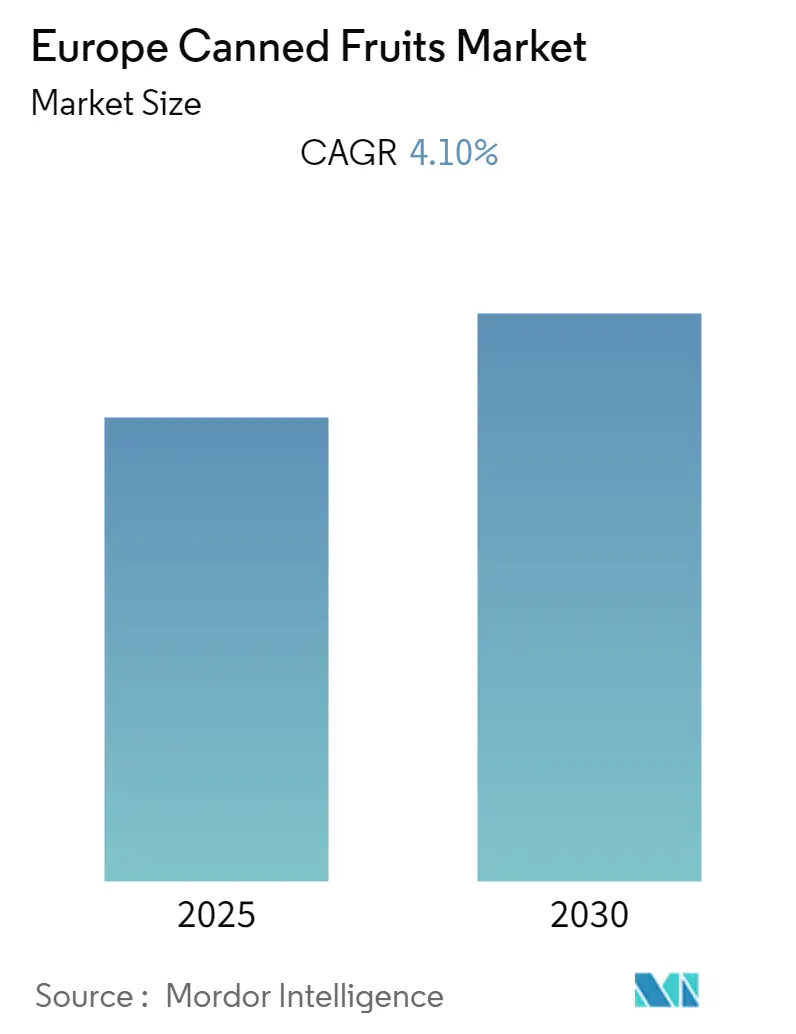
| Study Period | 2019 - 2030 |
| Base Year For Estimation | 2024 |
| Forecast Data Period | 2025 - 2030 |
| Historical Data Period | 2019 - 2023 |
| CAGR | 4.10 % |
| Market Concentration | Low |
Major Players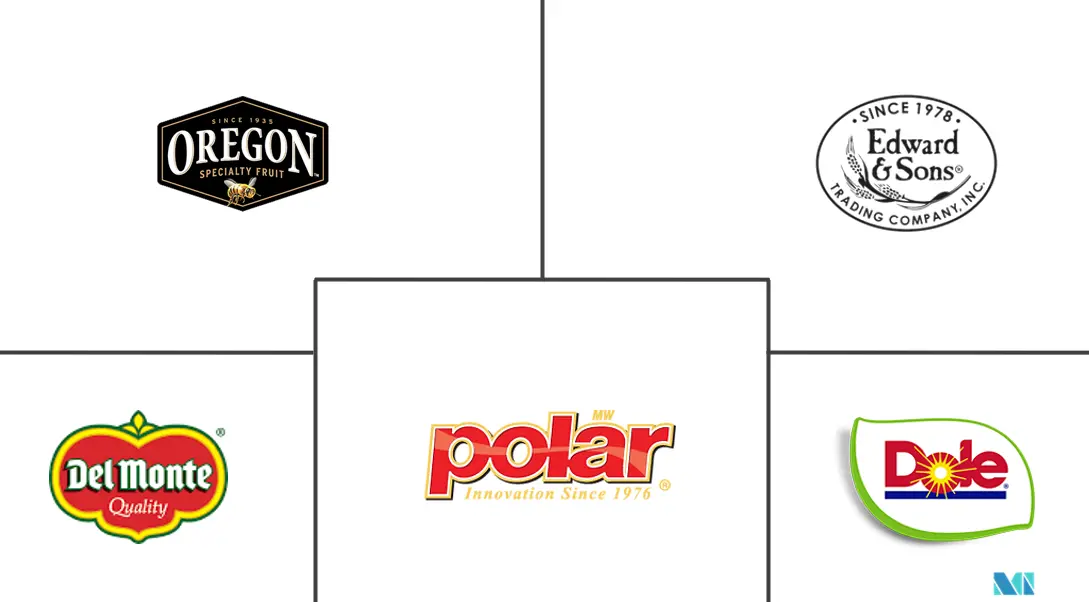
*Disclaimer: Major Players sorted in no particular order |
Europe Canned Fruits Market Analysis
The Europe Canned Fruits Market is expected to register a CAGR of 4.1% during the forecast period.
The increasing popularity of prepared food products, grab-on-go foods, and healthy snacking trends are fueling the demand for the canned fruits market. Additionally, advancements in canning technology, new product launches, and expanding distribution platforms are expected to support the growth of the market during the forecast period. Also, according to the Centre for the Promotion of Imports from developing countries (CBI), Europe is by far the largest importing region of canned fruits and vegetables, accounting for a share of over 70% of the world's total imports. European imports of canned fruits and vegetables have increased in value by 2.4% on average per year over the period 2015-2019. Almost 90% of imports from outside Europe come from developing countries.
Moreover, innovations that lead to the improvement of canning technology increased expenditure in research and development related to healthier food launches, better 'Nutri-score' labeling, and availability of more varieties of fruits are expected to support the growth of the market. Also, the expanding distribution network for canned food items in Europe is expected to contribute to market growth. Both online and offline shops dedicated to a specific category or regional products, such as Asian stores, vegan stores, organic stores, etc are expected to attract new consumer bases in the region. The long shelf life of canned fruits and vegetables remains an important factor supporting the canned fruits market.
However, the most frequent problems that have the potential to hamper the growth of the market are corrosion of packaging, excessive content of preservatives and coloring, as well as migration of materials from the packaging into the fruit such as tin or cadmium. These rejections and other food safety issues are handled directly by the trade without the government intervening in the region.
Europe Canned Fruits Market Trends
Government Initiatives To Provide Safe Food Is Increasing The Demand
While it is extremely rare, sometimes canned fruits that have been improperly prepared may contain harmful microorganisms like "Clostridium botulinum" causing botulism. Consuming such tainted canned fruits might result in botulism, a dangerous condition that, if untreated, can cause paralysis and death. In order to avoid such serious problems, the European government has come up with regulations those increases the trust among consumers in the region. For instance, the European Commission Regulation sets maximum levels for certain contaminants in food products, and this regulation is frequently updated. Apart from the limits set for general foodstuffs, there are also a number of specific contaminant limits for specific canned products. For canned products, there is one important limit on the inorganic tin, the package should not exceed a maximum of 200 mg/kg). Europe legislation has been laid down to regulate the presence of pesticide residues (MRLs) in food products. Therefore, producers, processors, and packers are adopting alternatives including the use of non-chemical methods and implementing Integrated Pest Management (IPM) to avoid any sort of rejections. The most common reasons for border rejections or market withdrawals of canned foods from the European market often relate to foreign bodies in the can, or defective packaging sometimes caused by corrosion. Although food safety certification is not obligatory under European legislation, there are legal guidelines for producers regarding food hygiene safety and traceability. Such government initiatives in the region to provide safe food to consumers have created a strong belief among them to purchase canned fruits which are boosting the market's growth.
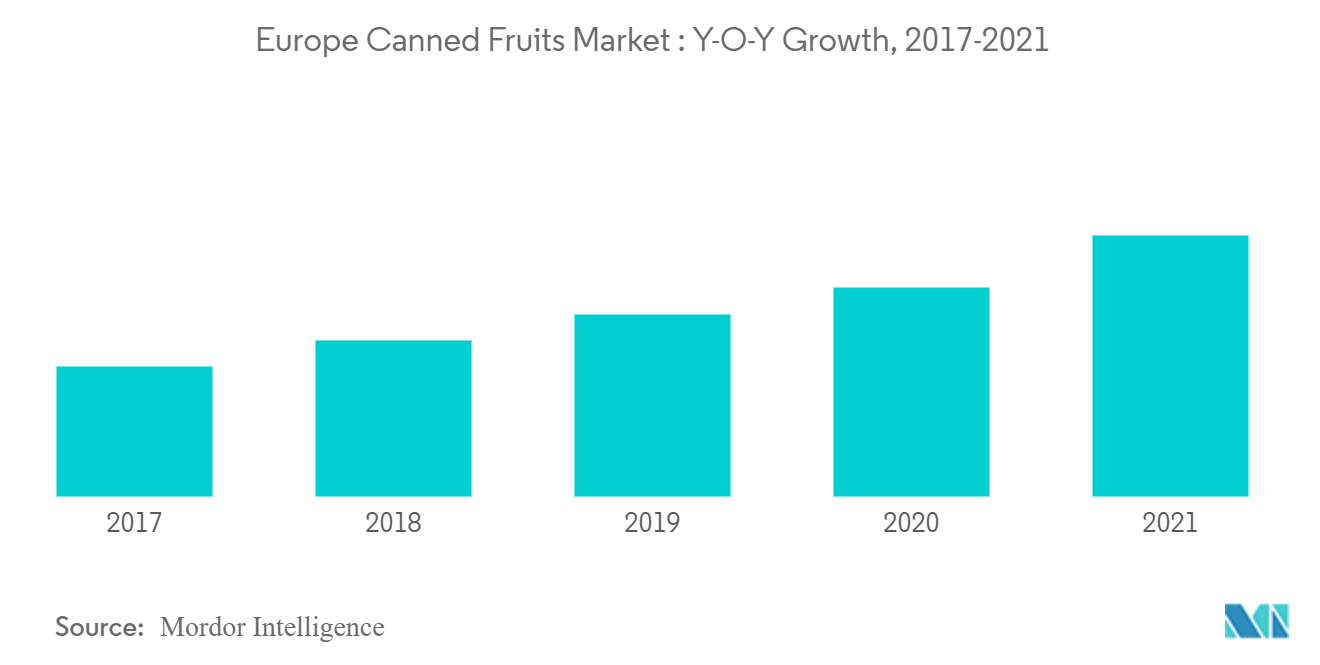
Expansion of Supermarkets/Hypermarkets to Boost the Growth Of The Market
The supermarkets & hypermarkets accounted for the major share of the Europe canned fruits market in 2021. In many highly populated countries in the region like Russia, Turkey, Germany, the United Kingdom, and France supermarkets & hypermarkets are the primary suppliers of canned fruits. The European supermarkets are distinctive in some ways, primarily their unique distribution models in the retail sector. The emergence of larger retail spaces in highly crowded places such as malls and supermarket chains and the growth of offering canned fruits through the online services they provide drove the expansion of the canned fruits market in the retail industry. Also, major supermarkets/hypermarkets are expanding their offline and online presence in the region. For instance, In November 2021, French supermarket group Carrefour announced it to spend USD 3.47 billion between 2022 and 2026 to set up digital commerce expansion as its strategic plan. Additionally, supermarkets stock a variety of canned fruit brand products which makes the consumer's selection wider and his choice a more well-informed one. For instance, in December 2021, according to the trade office of Vietnam in Europe, more than 20 tonnes of canned lychee from Vietnam hit the shelves of supermarkets in France for the first time.
Additionally, market growth is being driven by increasing retail infrastructure and the resulting increase in the number of supermarkets & hypermarkets in urban areas across Europe. Moreover, developments in refrigeration and transportation technologies have made it increasingly possible to ship perishable and lower-shelf-life products across continents with ease which is supporting the growth of the whole market. For instance, unopened canned fruits have a 1 to 2 years shelf life.
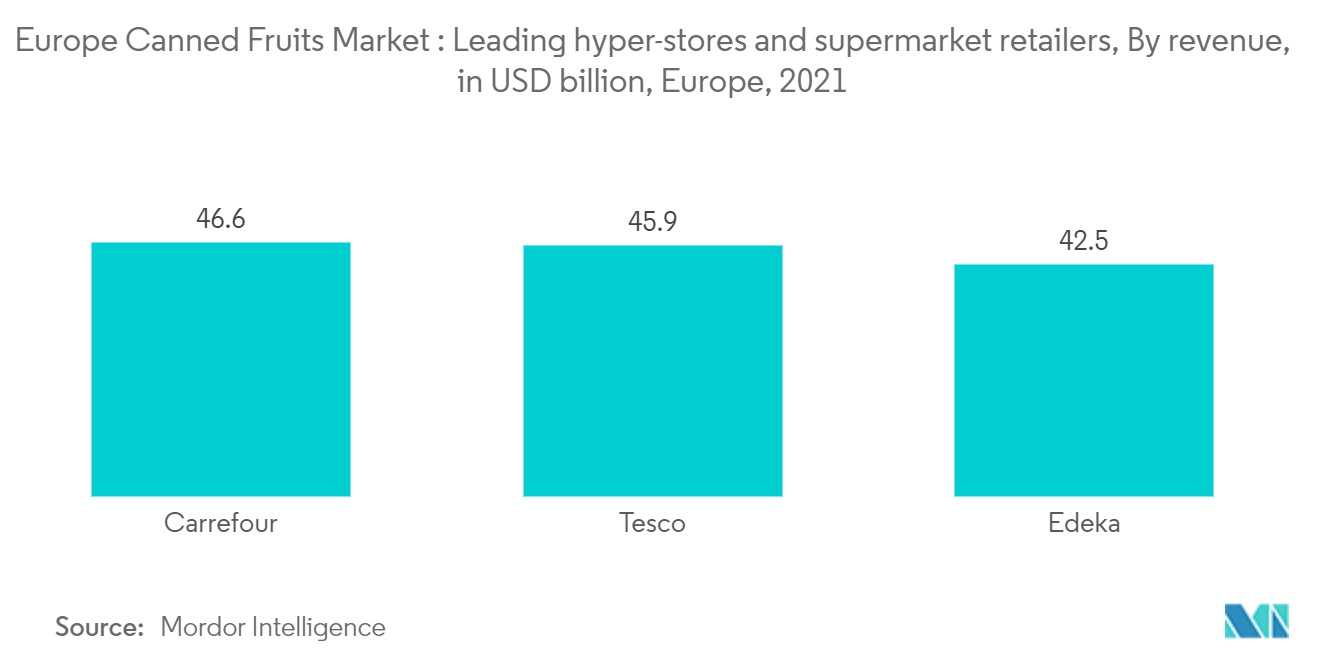
Europe Canned Fruits Industry Overview
The Europe canned fruits market is competitive with a number of players and various major companies are focusing on growth strategies such as product launches, acquisitions, and partnerships & collaborations. Seasonal and relevant promotional activities by the major players are also increasing awareness thus driving sales. For instance, in June 2022, Del Monte launched its summer campaign named "Hello Summer!" dedicated to Del Monte Gold pineapples. This campaign provided various advice, recipes, games, and competitions dedicated to the brand's flagship product. These activities have paved the way for the expansion of business and the customer base of market players. Regional players occupy a potential market share in the Europe canned fruits market. The market payers from the canned fruits market are anticipated to have lucrative growth opportunities in the future with the rising demand for canned fruits in the market. A few major players operating in the market are Dole, Del Monte Foods Holdings Limited, MW POLAR, Edward & Sons Trading Co., and Oregon Fruit Products.
Europe Canned Fruits Market Leaders
-
Dole
-
Del Monte Foods Holdings Limited
-
MW POLAR
-
Edward & Sons Trading Co.
-
Oregon Fruit Products
- *Disclaimer: Major Players sorted in no particular order
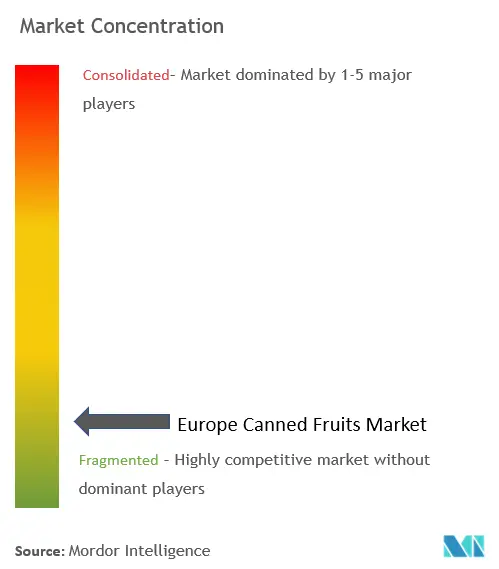
Europe Canned Fruits Market News
- In April 2022, Dole plc has confirmed that it will officially launch a new specialist for exotic fruits called 'Dole Exotics' and a 'BE Exotic' consumer brand during Fruit Logistica 2022.
- In April 2022, DOLE joined Freshfel, the European fresh produce association in embarking on an Environmental Footprint Initiative to develop a fresh fruit and vegetable environmental footprint methodology and digital tool. The company claimed that its shared objective is to develop an objective, standardized environmental footprint methodology, database, and digital tool for the fresh produce sector that is broadly accepted by the industry, stakeholders, and consumers.
- In December 2020, Del Monte, the canned fruit brand announced its six-month partnership with food writer and anti-food poverty campaigner, Jack Monroe, to promote the positive benefits of eating canned fruit, such as health, versatility, convenience, and value.
Europe Canned Fruits Industry Segmentation
Fruits that have been sterilized and sealed in an airtight container with or without syrup, water, or another liquid are referred to as canned fruits. Europe's canned fruit market is segmented by fruit type, distribution channel, and geography. By fruit type, the market is segmented into peaches, pineapples, mandarin oranges, pears, and other fruit types. Based on the distribution channel, the market is segmented into supermarkets/hypermarkets, convenience stores/grocery stores, online retail stores, and other distribution channels. By geography, this report includes an analysis of countries like Spain, the United Kingdom, Germany, France, Italy, Russia, and the Rest of Europe). The report offers market size and forecasts in value (USD million) for the above segments.
| By Fruit Type | Peaches |
| Pineapple | |
| Mandarin Oranges | |
| Pears | |
| Other Fruits | |
| By Distibution Channel | Hypermarket/Supermarket |
| Convenience Stores | |
| Online Retail | |
| Other Distribution Channels | |
| By Country | Spain |
| United Kingdom | |
| Germany | |
| France | |
| Italy | |
| Russia | |
| Rest of Europe |
Europe Canned Fruits Market Research FAQs
What is the current Europe Canned Fruits Market size?
The Europe Canned Fruits Market is projected to register a CAGR of 4.1% during the forecast period (2025-2030)
Who are the key players in Europe Canned Fruits Market?
Dole, Del Monte Foods Holdings Limited, MW POLAR, Edward & Sons Trading Co. and Oregon Fruit Products are the major companies operating in the Europe Canned Fruits Market.
What years does this Europe Canned Fruits Market cover?
The report covers the Europe Canned Fruits Market historical market size for years: 2019, 2020, 2021, 2022, 2023 and 2024. The report also forecasts the Europe Canned Fruits Market size for years: 2025, 2026, 2027, 2028, 2029 and 2030.
Our Best Selling Reports
Europe Canned Fruits Industry Report
Statistics for the 2025 Europe Canned Fruits market share, size and revenue growth rate, created by Mordor Intelligence™ Industry Reports. Europe Canned Fruits analysis includes a market forecast outlook for 2025 to 2030 and historical overview. Get a sample of this industry analysis as a free report PDF download.




